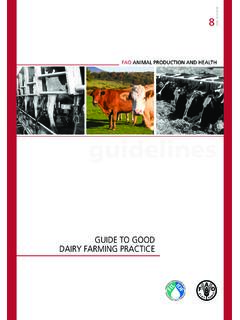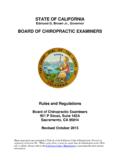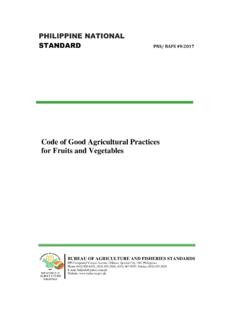Transcription of Codex Alimentarius - Milk and Milk Products Second edition
1 Milk and Milk ProductsSecond editionISSN 0259-2916 Milk and Milk ProductsSecond editionWORLD HEALTH ORGANIZATIONFOOD AND AGRICULTURE ORGANIZATION OF THE UNITED NATIONSRome, i24/10/2011 designations employed and the presentation of material in this information product do not imply the expression of any opinion whatsoever on the part of the Food and Agriculture Organization of the United Nations (FAO) or of the World Health Organization (WHO) concerning the legal or development status of any country, territory, city or area or of its authorities, or concerning the delimitation of its frontiers or boundaries. The mention of specific companies or Products of manufacturers, whether or not these have been patented, does not imply that these have been endorsed or recommended by FAO or WHO in preference to others of a similar nature that are not mentioned.
2 ISBN 978-92-5-105837-4 All rights reserved. Reproduction and dissemination of material in this information product for educational or other non-commercial purposes are authorized without any prior written permission from the copyright holders provided the source is fully acknowledged. Reproduction of material in this information product for resale or other commercial purposes is prohibited without written permission of the copyright holders. Applications for such permission should be addressed to: Chief Electronic Publishing Policy and Support BranchCommunication Division FAO Viale delle Terme di Caracalla, 00153 Rome, Italy or by e-mail to: FAO and WHO ii24/10/2011 R E F A C ETHE Codex Alimentarius COMMISSIONThe Codex Alimentarius Commission is an intergovernmental body with over 180 members established by the Food and Agriculture Organization of the United Nations (FAO) and the World Health Organization (WHO).
3 The C O D E X A L I M E N T A R I U S is the main result of the Commission s work: a set of international food standards, guidelines and codes of practice with the goal to protect the health of consumers and ensure fair practices in the food AND MILK PRODUCTSS econd editionThis compilation contains in one volume all Codex standards and related texts for milk and milk Products adopted by the Codex Alimentarius Commission up to information on these texts, or any other aspect of the Codex Alimentarius Commission, may be obtained from:Secretariat of the Codex Alimentarius CommissionJoint FAO/WHO Food Standards ProgrammeViale delle Terme di Caracalla00153 Rome, ItalyFax: +39 06 57054593E-mail: iii19/11/2011 O N T E N T SPREFACE iiiStandards for milk productsMilk powders and cream powder ( Codex STAN 207-1999) 1 Fermented milks ( Codex STAN 243-2003) 6 Blend of evaporated skimmed milk and vegetable fat ( Codex STAN 250-2006) 17 Blend of skimmed milk and vegetable fat in powdered form ( Codex STAN 251-2006) 21 Blend of sweetened condensed skimmed milk and vegetable fat ( Codex STAN 252-2006) 25 Dairy fat spreads ( Codex STAN 253-2006) 29 Butter ( Codex STAN 279-1971) 36 Milkfat Products ( Codex STAN 280-1973)
4 38 Evaporated milks ( Codex STAN 281-1971) 41 Sweetened condensed milks ( Codex STAN 282-1971) 45 Cream and prepared creams ( Codex STAN 288-1976) 49 Whey powders ( Codex STAN 289-1995) 56 Edible casein Products ( Codex STAN 290-1995) 59 Horizontal cheese standardsCheeses in brine ( Codex STAN 208-1999) 64 Group standard for unripened cheese including fresh cheese ( Codex STAN 221-2001) 67 Extra hard grating cheese ( Codex STAN 278-1978) 73 General standard for cheese ( Codex STAN 283-1978) 76 Standard for whey cheeses ( Codex STAN 284-1971) 83 Individual cheese standardsMozzarella ( Codex STAN 262-2006) 86 Cheddar ( Codex STAN 263-1966) 93 Danbo ( Codex STAN 264-1966) 99 Edam ( Codex STAN 265-1966) 104 Gouda ( Codex STAN 266-1966) 109 Havarti ( Codex STAN 267-1966) 115 Sams ( Codex STAN 268-1966) 120 Emmental ( Codex STAN 269-1967) 125 Tilsiter ( Codex STAN 270-1968) 131 Saint-Paulin ( Codex STAN 271-1968) 136 Provolone ( Codex STAN 272-1968)
5 142 Cottage cheese ( Codex STAN 273-1968) 148 Coulommiers ( Codex STAN 274-1969) 154 Cream cheese ( Codex STAN 275-1973) 159 Camembert ( Codex STAN 276-1973) 166 Brie ( Codex STAN 277-1973) 171 General texts for milk and milk productsGeneral standard for the use of dairy terms ( Codex STAN 206-1999) 176 code of hygienic practice for milk and milk Products (CAC/RCP 57-2004) 181 Guidelines for the preservation of raw milk by use of the lactoperoxidase system (CAC/GL 13-1991) 233 Model export certifi cate for milk and milk Products (CAC/GL 67-2008) v19/11/2011 STANDARD FOR MILK POWDERS AND CREAM POWDERCODEX STAN 207-19991. SCOPEThis Standard applies to milk powders and cream powder, intended for direct consumption or further processing, in conformity with the description in Section 2 of this DESCRIPTIONMilk powders and cream powder are milk Products which can be obtained by the partial removal of water from milk or cream.
6 The fat and/or protein content of the milk or cream may have been adjusted, only to comply with the compositional requirements in Section 3 of this Standard, by the addition and/or withdrawal of milk constituents in such a way as not to alter the whey protein to casein ratio of the milk being ESSENTIAL COMPOSITION AND QUALITY Raw materialsMilk and creamThe following milk Products are allowed for protein adjustment purposes: Milk retentate Milk retentate is the product obtained by concentrating milk protein by ultrafi ltration of milk, partly skimmed milk, or skimmed milk; Milk permeate Milk permeate is the product obtained by removing milk proteins and milkfat from milk, partly skimmed milk, or skimmed milk by ultrafi ltration; and CompositionCream powderMinimum milkfat42% m/mMaximum water(a)5% m/mMinimum milk protein in milk solids-not-fat(a)34% m/m1 See Standard for Sugars ( Codex STAN 212-1999).
7 This Standard replaced the Standard for Whole Milk Powder, Partly Skimmed Milk Powder and Skimmed Milk Powder (A-5-1971) and the Standard for Cream Powder, Half Cream Powder and High Fat Milk Powder (A-10-1971). Adopted in 1999. Amendment 124/10/2011 AND MILK Products (2nd edition )2 Whole milk powderMilkfatMinimum 26% and less than 42% m/mMaximum water(a)5% m/mMinimum milk protein in milk solids-not-fat(a)34% m/mPartly skimmed milk powderMilkfatMore than and less than 26% m/mMaximum water(a)5% m/mMinimum milk protein in milk solids-not-fat(a)34% m/mSkimmed milk powderMaximum m/mMaximum water(a)5% m/mMinimum milk protein in milk solids-not-fat(a)34% m/m(a) The water content does not include water of crystallization of the lactose; the milk solids-not-fat content includes water of crystallization of the FOOD ADDITIVESOnly those food additives listed below may be used and only within the limits specifi of additiveMaximum levelStabilizers331 Sodium citrates5 000 mg/kg singly or in combination.
8 Expressed as anhydrous substances332 Potassium citratesFirming agents508 Potassium chlorideLimited by GMP509 Calcium chlorideLimited by GMPA cidity regulators339 Sodium phosphates5 000 mg/kg singly or in combination expressed as anhydrous substances340 Potassium phosphates450 Diphosphates451 Triphosphates452 Polyphosphates500 Sodium carbonates501 Potassium carbonatesEmulsifi ers322 Lecithins Limited by GMP471 Mono- and diglycerides of fatty acids2 500 224/10/2011 POWDERS AND CREAM POWDER ( Codex STAN 207-1999)3 INS of additiveMaximum levelAnticaking agents170(i)Calcium carbonate10 000 mg/kg singly or in combination341(iii)Tricalcium phosphate343(iii)Trimagnesium phosphate504(i)Magnesium carbonate530 Magnesium oxide551 Silicon dioxide, amorphous552 Calcium silicate553 Magnesium silicates554 Sodium aluminosilicate556 Calcium aluminium silicate559 Aluminium silicateAntioxidants300 Ascorbic acid, L-500 mg/kg expressed as ascorbic acid301 Sodium ascorbate304 Ascorbyl palmitate320 Butylated hydroxyanisole100 mg/kg5.
9 CONTAMINANTSThe Products covered by this Standard shall comply with the Maximum Levels for contaminants that are specifi ed for the product in the General Standard for Contaminants and Toxins in Food and Feed ( Codex STAN 193-1995).The milk used in the manufacture of the Products covered by this Standard shall comply with the Maximum Levels for contaminants and toxins specifi ed for milk by the General Standard for Contaminants and Toxins in Food and Feed ( Codex STAN 193-1995) and with the maximum residue limits for veterinary drug residues and pesticides established for milk by the HYGIENEIt is recommended that the Products covered by the provisions of this standard be prepared and handled in accordance with the appropriate sections of the General Principles of Food Hygiene (CAC/RCP 1-1969), the code of hygienic Practice for Milk and Milk Products (CAC/RCP 57-2004)
10 And other relevant Codex texts such as Codes of hygienic Practice and Codes of Practice. The Products should comply with any microbiological criteria established in accordance with the Principles for the Establishment and Application of Microbiological Criteria for Foods (CAC/GL 21-1997). 324/10/2011 AND MILK Products (2nd edition )47. LABELLINGIn addition to the provisions of the General Standard for the Labelling of Prepackaged Foods ( Codex STAN 1-1985) and the General Standard for the Use of Dairy Terms ( Codex STAN 206-1999), the following specifi c provisions Name of the foodThe name of the food shall be:Cream powderaccording to the composition in Section milk powderPartly skimmed milk powderSkimmed milk powderPartly skimmed milk powder may be designated Semi-skimmed milk powder provided that the content of milkfat does not exceed 16% m/m and is not less than 14% allowed by national legislation or otherwise identifi ed to the consumer in the country where the product is sold, whole milk powder may be designated full cream milk powder and skimmed milk powder may be designated low fat milk powder.


















